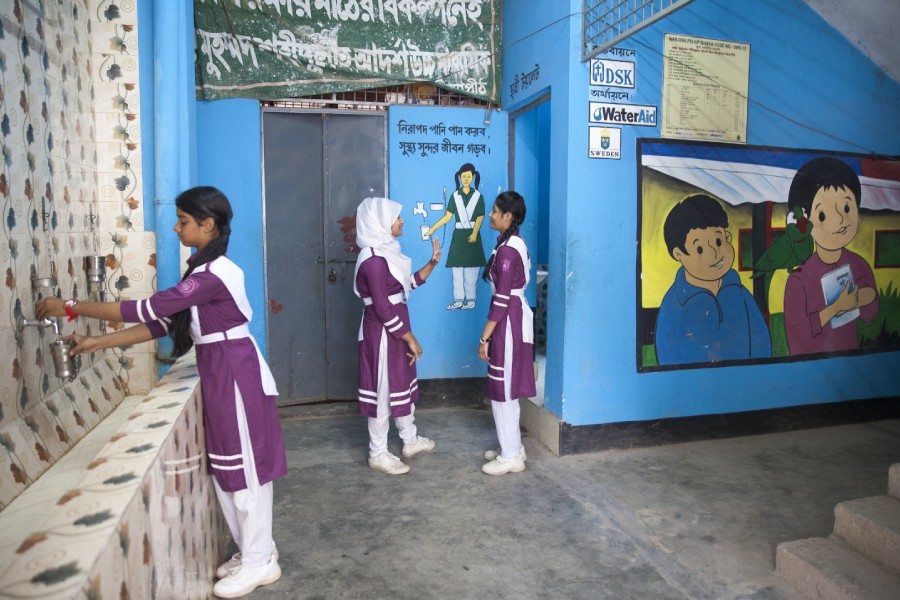Most of the educational institutions have yet to comply with the government's directives to improve sanitation due to lack of monitoring system, experts said.
To this end, the education ministry issued a circular on June 20 in 2015. The main reference was the Bangladesh National Hygiene Baseline Survey published in 2014.
In the circular, the school managing committee was given responsibility to monitor the cleanliness of school toilets while keeping a separate fund for appointing necessary manpower in this regard.
The teachers were also given responsibility to lead the cleanliness issues of the toilets of the educational institutions.
The toilets must be gender-friendly with a female teacher being designated as the focal person to talk openly about menstrual hygiene management (MHM) with girl students.
The education officers at upazila and district level, inspectors, local administration officials and other high officials were also instructed to report on water supply, toilet facilities, toilets for girls and hand-wash facilities at educational institutions.
Development Organisation of the Rural Poor (DORP) chief (Research, Evaluation & Monitoring) Zobair Hasan told the FE that the roles and responsibilities to ensure MHM-friendly toilets at educational institutions have not been defined in any national documents.
The institutions themselves are responsible for constructing infrastructures through the school management committees. But local government institutions and department of public health engineering (DPHE) also have responsibilities to ensure WASH, he added.
He laid emphasis on formulation of a National MHM Strategy in line with the Sustainable Development Goals (SDGs) targets to address the present MHM issues. It will also help effectively operationalise the circular issued by the education ministry.
Besides, the strategy is required to localise the implementation of SDG commitments as most of the people don't know about SDG goals, Mr Zobair explained.
It was found from the Policy Paper of DORP that the amount of budget required for MHM-friendly toilets and WASH facilities at schools has not been specified in any of the governmental documents or circulars.
The SDGs Financing Strategy 2017 has also not provided any clear guideline about the investment in WASH at schools which would help girl students with decent MHM.
"Conversely, the 7th Five-Year Plan (7th FYP) 2016-2020 underscored the importance of 'inclusive' and separate toilets for girls with adequate facilities for sanitary pads and cleansing facilities," the policy paper mentioned.
When contacted, a senior official of General Economics Division (GED) involved with preparation of 7th FYP said he could not remember what were the instructions regarding WASH and MHM-friendly toilets at educational institutions.
Menstrual Hygiene Management (MHM) is one of the core issues that needs proper policy attention to achieve at least five SDGs -- healthy life and wellbeing (Goal 3), access to water and sanitation for all (Goal 6), school attendance and performance of girl students (Goal 4), gender equality and empowerment of all women and girls (Goal 5) and full and productive employment for both men and women (Goal 8).
Available, accessible, acceptable and quality water, sanitation and hygiene facilities at schools are integral part of MHM for girl students, but they are unfortunately neglected issues in Bangladesh due to lack of MHM-friendly toilets at schools.
Therefore, the goals and targets related to MHM for school-attending girls are unlikely to be achieved without adequate policy and budgetary attention, the DORP policy paper mentioned.
If girls lack access to affordable, hygienic menstrual products, they often use old rags, cloths or other unhygienic materials.
This can lead to reproductive tract infections (RTIs) and other health complications. Decent MHM at schools promotes social inclusion and individual self-esteem, and it is an integral part of quality and enjoyment of education, experts said.
According to the National Hygiene Baseline Survey 2014, 86 per cent of the female students use old cloths during menstruation. Besides around a quarter of female students do not go to school during menstruation and almost one-third thinks that menstrual problems interfered with school performance.
According to the same survey, on average the number of students per school toilet was 187 while the recommended number is 50 as per the Sector Development Plan (SDP) 2011-2025.
As per the directive of the SDP 2011-2025, budgetary allocation is a must to enable schools to construct new separate toilets for girl students and maintain the toilet-student ratio at 1:50 instead of 1:187 which is indecent.
Mr Zobair said it was found from resource tapping that if union parishad, upazila parishad and district facility department provide resources and these resources are used for toilets, it becomes easy to implement the directives.


